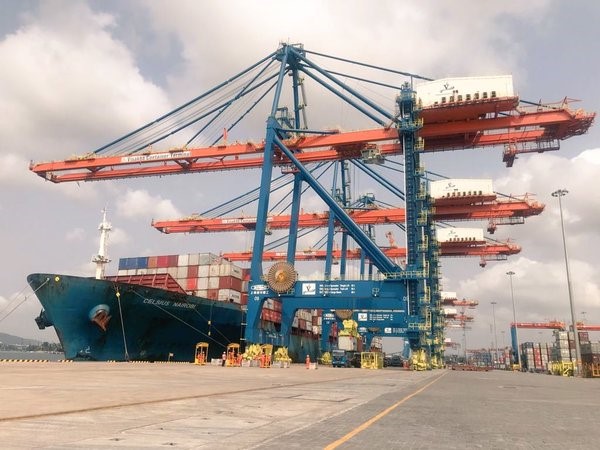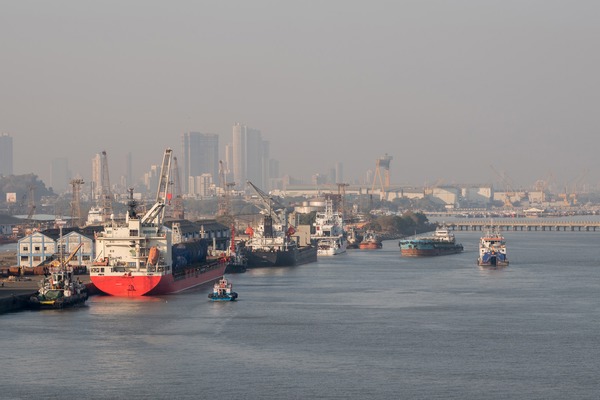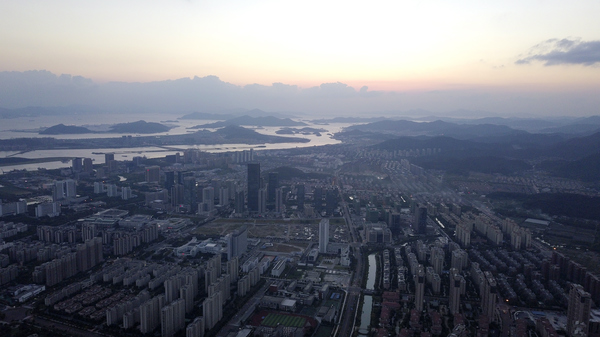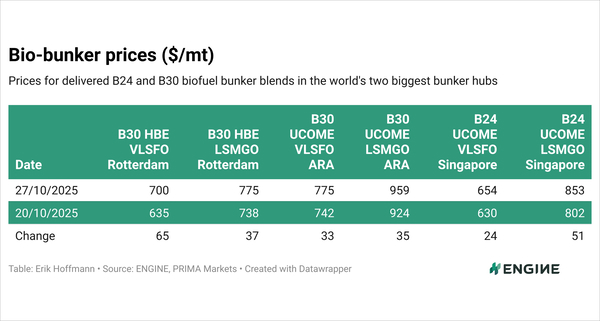East of Suez Fuel Availability Outlook 28 Oct 2025
Bunker demand low in Singapore
Several Indian ports brace for Severe Cyclonic Storm Montha
Prompt availability tight in Fujairah
 IMAGE: Container ship berthed at the port of Visakhapatnam. @vptIndia via Twitter
IMAGE: Container ship berthed at the port of Visakhapatnam. @vptIndia via Twitter
Singapore and Malaysia
VLSFO lead times in Singapore remain highly uneven despite muted demand this week. Some suppliers can deliver within four days, while others require over two weeks’ notice due to congested delivery schedules.
LSMGO lead times now range between 4–9 days, compared with about six days last week, while HSFO deliveries still need 6–11 days, showing little change week on week.
Singapore’s residual fuel oil stocks have averaged 4% lower so far in October than across September, according to the latest data from Enterprise Singapore. The port’s fuel oil inventories have fallen below 24 million bbls amid a 22% drop in net fuel oil imports this month. So far, imports have decreased by 101,000 bbls, while exports have surged by 606,000 bbls. In contrast, middle distillate stocks at the port have averaged 1% higher over the same period.
At Malaysia’s Port Klang, VLSFO and LSMGO remain readily available, with prompt deliveries possible for smaller quantities, though HSFO supply continues to be tight.
East Asia
Bunker demand in Zhoushan remains muted, with most suppliers advising 6–8 days of lead time for VLSFO, slightly longer than 5–7 days last week. HSFO lead times have also lengthened from around four days to 6–8 days, while LSMGO lead times remain steady at 2–4 days.
Fuel availability is uneven across northern China. Dalian and Qingdao have adequate supplies of VLSFO and LSMGO, while HSFO remains tight in Qingdao. Tianjin continues to face shortages across all grades. In Shanghai, supplies of VLSFO and HSFO are constrained, while LSMGO availability is comparatively stable.
Further south, conditions vary: VLSFO and LSMGO stocks are limited in Fuzhou, VLSFO supply is sufficient in Xiamen, but LSMGO is tight. Meanwhile, Yangpu and Guangzhou have restricted delivery options for both grades.
In Hong Kong, lead times for all fuels remain around seven days, while Taiwan’s bunker market stays steady, with VLSFO and LSMGO typically deliverable within two days at Keelung, Taichung, Hualien and Kaohsiung.
Bunker demand in South Korea has eased, influenced by adverse weather conditions. Fuel availability has improved across all grades, with lead times reduced from around 11 days last week to 6–8 days now.
However, bunkering disruptions are expected due to bad weather — in Busan and Ulsan between 2–3 November, and in Yeosu and Daesan between 1–3 November, according to a source.
In Japan, prompt VLSFO supply remains tight across major ports including Tokyo, Chiba, Yokohama, Kawasaki, Osaka, Kobe, Sakai, Mizushima, Nagoya and Yokkaichi. LSMGO is well supplied nationwide, though prompt deliveries can be difficult in Mizushima. B24-VLSFO is available only on request in Tokyo, Chiba, Kawasaki and Yokohama.
Meanwhile, HSFO supply has tightened at most ports, with Oita reporting shortages across all grades — VLSFO, LSMGO, and HSFO.
Oceania
In Western Australia, VLSFO and LSMGO are readily available in Kwinana and Fremantle, with most suppliers quoting lead times of around seven days. Deliveries are primarily conducted by barge from a single supplier, while LSMGO can also be trucked in. However, strong afternoon winds occasionally disrupt bunkering operations, a source said.
In New South Wales, suppliers in Port Kembla offer VLSFO via both truck and pipeline, with a minimum pipeline delivery of 70 mt, and smaller parcels supplied by truck. In Sydney, one barge operates alongside truck and pipeline options at select berths, though its schedule is sometimes affected by naval activity and cruise liner movements. Both VLSFO and LSMGO stocks remain healthy, while HSFO supply is limited. Across all grades, suppliers prefer lead times of around seven days.
In Queensland, VLSFO and LSMGO are readily available at Brisbane and Gladstone, with lead times of about seven days. HSFO in Brisbane is available only on request, while Gladstone may experience occasional weather-induced disruptions. Berth access at Brisbane’s AAT terminal can be challenging. The port now has two barges operated by separate suppliers, both offering VLSFO and LSMGO, with HSFO available on enquiry.
In Victoria, Melbourne and Geelong maintain strong stocks of VLSFO and LSMGO, though HSFO remains tight, especially for prompt deliveries. Currently, Melbourne holds adequate HSFO inventory. A single barge serves both ports, and Bass Strait weather occasionally affects operations. Seven days’ lead time is generally recommended. LSMGO can also be trucked to smaller ports like Portland and Port Welshpool, where lead times average 2–3 days.
Overall, Australian ports continue to maintain stable bunker supply, typically requiring around seven days of lead time, though deliveries within 3–4 days are often possible due to ample product availability. Ports with pipeline systems, such as Darwin and Dampier, rely partly on truck deliveries.
In New Zealand, bunker supply remains steady, with VLSFO readily available at Tauranga and Auckland. Tauranga offers pipeline access at specific berths, while Marsden Point can supply both VLSFO and LSMGO via pipeline at jetties where vessels are engaged in cargo operations.
Looking ahead, the cyclone season in northern Australia—from 1 November to 30 April—is expected to cause intermittent bunkering disruptions, a source said.
South Asia
Severe Cyclonic Storm Montha was located about 180 km south-southeast of Kakinada in Andhra Pradesh this afternoon, with the sea in full spate as it moves north-northwest and prepares to make landfall between Machilipatnam and Kalingapatnam, near Kakinada, later today, according to the India Meteorological Department (IMD).
Heavy rain, strong winds and rough sea conditions are forecast along India’s east coast from Tamil Nadu to Odisha over the next two days, prompting alerts for Odisha, West Bengal, Tamil Nadu and Andhra Pradesh.
At Kakinada Deep Water Port and anchorage, port operations and vessel movements were suspended on 26 October evening, with a warning issued as a cautionary measure.
In Vizag, cargo operations and LPG berthing remain suspended, though inner harbour navigation continues. Working vessels have been advised to reinforce moorings and keep engines ready for sea departure at short notice. A cautionary flag remains in place.
At Gangavaram, cargo operations are suspended, and vessels are retained alongside, with potential shifts to anchorage if conditions deteriorate.
Meanwhile, ports at Chennai, Ennore, Kattupalli and Karaikal continue normal operations, though a warning has been issued and vessels have been placed on alert as a precaution, according to GAC Hot Port News.
In Sri Lanka, a supplier is now quoting lead times of around five days for all fuel grades in Colombo and Hambantota, slightly up from about three days last week.
Middle East
In Fujairah, prompt bunker availability remains constrained across all fuel grades despite muted demand, as several suppliers struggle with low inventories and loading delays. Lead times of 5–7 days are generally recommended, reflecting similar conditions at the nearby Khor Fakkan port. Some suppliers can still manage urgent deliveries, though typically at a higher cost, a source noted.
In Iraq’s Basrah, VLSFO and LSMGO remain readily available, while HSFO continues to be in short supply. Availability of both grades has improved in Saudi Arabia’s Jeddah, though port congestion continues to slow operations.
Egypt’s Port Suez is grappling with acute shortages, with VLSFO, LSMGO and HSFO stocks nearly exhausted. Qatar’s Ras Laffan is also facing tight supply of VLSFO and LSMGO.
Bunker supply is very tight in Djibouti, with VLSFO and HSFO almost exhausted and LSMGO running low.
In contrast, Oman’s ports — Sohar, Salalah, Muscat and Duqm — continue to maintain steady supply of LSMGO.
By Tuhin Roy
Please get in touch with comments or additional info to news@engine.online

Contact our Experts
With 50+ traders in 12 offices around the world, our team is available 24/7 to support you in your energy procurement needs.



